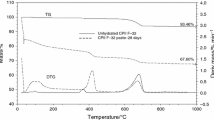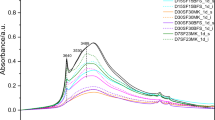Abstract
A simple water sorption/retention (WS/WR) test, followed by stepwise static heating, was applied to the study of cement quality and the reactivity of its grain surface. The physically bound water and hence the specific surface both in the unhydrated and in the hydrated state were estimated as a function of the hydration time. Rehydration after heating at 220°C and contact with air was different inWS from that inWR samples, which indicates a difference in microstructure. XRD proved the formation of portlandite during the sorption test and eventual heating at 200°C, and its transformation into carbonates on contact with air, especially on heating at 400°C. The contents of these compounds were estimated from the mass difference between 400 and 800°C, which was compatible with the mass change between 220 and 400°C and this indicates surface reactivity. The test may serve for the routine study of cement.
Zusammenfassung
Zur Untersuchung der Zementqualität und der Reaktivität seiner Kornoberfläche wurde ein einfacher Wassersorptions/-retentionstest (WS/WR), gefolgt von schrittweisem statischem Erhitzen angewendet. Die Menge physikalisch gebundenen Wasser und somit die spezifische Oberfläche sowohl im unhydratierten als auch im hydratierten Zustand wurden als eine Funktion der Hydratierungszeit geschätzt Rehydratierung nach Erhitzen bei 220°C und Kontaktieren mit Luft ist fürWS- und fürWR-Proben verschieden, was eine Differenz der Mikrostruktur anzeigt. Röntgendiffraktion belegt die Bildung von Portlandit während des Sorptionstests und schließlichem Erhitzen bei 220°C sowie seine Umwandlung in Karbonate durch den Kontakt mit Luft, besonders beim Erhitzen bei 400°C. Der quantitative Anteil dieser Substanzen wurde anhand der Massendifferenz zwischen 400 und 800°C geschätzt, was mit der Massenänderung zwischen 220 und 400°C vereinbar ist und dies zeigt die Oberflächenreaktivität an. Dieser Test kann als Routineuntersuchung für Zement dienen.
Similar content being viewed by others
References
E. T. Stepkowska, J. L. Perez-Rodriguez, A. Justo, P. J. Sanchez-Soto, M. A. Aviles and J. M. Bijen, 13th NSTAC, Thermochim. Acta, 214 (1993) 97.
E. T. Stepkowska, J. M. Bijen, J. L. Perez-Rodriguez and A. Justo, Proc. 9th Intern. Congr. Chem. of Cement, Vol. 5, New Delhi 1992, p 247–253.
E. T. Stepkowska, Engineering Geology, 28 (1990) 249.
E. T. Stepkowska and S. A. Jefferis, Thermochim. Acta, 114 (1987) 179.
A. R. Ramachandranet al., Symp. on Microstructural Development During Hydration of Cement, Boston, Mater. Res. Soc. Symp. Proc., 85 (1986) 33.
K. van Breugel, Simulation of Hydration and Formation of Structure in Hardening Cement-Based Materials, Techn. Univ. Delft, 1991.
P. Barnes, Structure and performance of cements, Appl. Sci. Publ. London, 1983.
F. M. Lea, The Chemistry of Cement and Concrete, E. Arnold Publ. 1970.
T. C. Powers, Cement and Concrete Ass., London, 1968, p. 319.
J. Hagymassyet al., J. Colloid Interface Sci., 29 (1969) 152.
T. C. Powerset al., J. American Concrete Institute, 1946/1947, Parts 1–9.
Z. Larionova, L. Nikitina and V. Garashin, Phase composition, microstructure and strength of cement stone and concrete, Stroyizdat, Moscow, 1977 (in Russian).
L. E. Copelandet al., Proc. 4th Intern. Congr. on the Chemistry of Cements, Wash., Vol. I, 1960, p. 429.
E. E. Lachowski and S. Diamond, Cem. Concr. Res., 13 (1983) 177.
R. Angelova and D. Evstatiev Proc. 6th Intern. IAEG Congress, Balkema, 1990, p. 3147.
S. Yariv and H. Cross, “Geochemistry of Colloid Systems”, Springer Verlag, Berlin, 1979.
S. Yariv, Isr. J. Chem. 9 (1971) 695.
A. Fraay and P. Wandenier, Stevinrapport: 25.1-90-02/C, T. U. Delft Sectie Materiaalkunde.
Z. Sanman, Silikaty, 8 (1964) 185.
E. T. Stepkowska, C. Maqueda, J. L. Perez-Rodriguez, A. Justo, E. Gomez, Proc. 7th EUROCLAY Conf., Dresden, 1991, p. 1001–1005.
E. T. Stepkowska, Z. Sulek, J. L. Perez-Rodrigez, A. Justo and C. Maqueda, J. Thermal Anal., 37 (1991) 1497.
J. M. Criado, M. Macias and A. Macias-Machin, Report of Instituto de Ciencia de Meteriales, 41072 Sevilla, Spain, 1991.
K. Kostyrko and M. Skoczylas, J. Thermal Anal., 38 (1992) 2181.
E. T. Stepkowska, Arch. Hydrotechniki, 24 (1977) 3, 411.
Author information
Authors and Affiliations
Additional information
Dedicated to Professor Lisa Heller-Kallai on the occasion of her 65th birthday
Rights and permissions
About this article
Cite this article
Stepkowska, E.T., Bijen, J.M.J.M., Perez-Rodriguez, J.L. et al. Thermal mass changes of portland cement and SLAG cements after water sorption. Journal of Thermal Analysis 42, 41–65 (1994). https://doi.org/10.1007/BF02546991
Issue Date:
DOI: https://doi.org/10.1007/BF02546991




